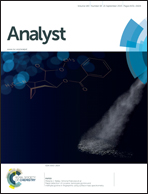A label-free and time-resolved luminescence strategy for the detection of proteins based on DNA–Tb3+ luminescence quenched by graphene oxide†
Abstract
A sensitive, label-free and time-resolved luminescent aptasensor to detect proteins was developed based on the DNA-enhanced time-resolved luminescence of Tb3+ and graphene oxide (GO). We found that the DNA no matter with a G-quadruplex structure or not could greatly enhance the long-lived emission of Tb3+, and the luminescence of DNA–Tb3+ could be effectively quenched by GO after the DNA–Tb3+ was adsorbed onto GO. The target protein combined with an aptamer to form a protein/DNA complex restrained the quenching of DNA–Tb3+ emission by GO. Thrombin and a 29-mer anti-thrombin aptamer were employed as a model analyte and a recognition element. There is a good linear relationship between the aptamer–Tb3+ complex luminescence with the thrombin concentrations of 1 to 100 nM with a low detection limit of 0.8 nM. Since the time-resolved luminescence can eliminate the unspecific background fluorescence, the proposed aptasensor has been successfully applied in complicated biological samples for thrombin detection. This novel strategy presents a potential universal method for detection of other molecules.


 Please wait while we load your content...
Please wait while we load your content...